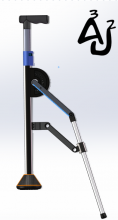Better Than Crutches!
Background
Current crutches often pose challenges for users, particularly when navigating stairs or walking on uneven terrain, such as uphill or downhill slopes. The traditional design lacks flexibility and adaptability to these varied surfaces, making it difficult to maintain balance and stability. This can lead to an increased risk of falls or injuries. Additionally, the effort required to use crutches on such challenging surfaces can exacerbate existing conditions. The inspiration behind the project is that we saw people using a crutch to walk in UCI, which is hard, so we want to build an automatic crutch that can adjust the height when needed. Our crutches provide safety, stability and comfort while being simple to operate.
Goal
We aim to Design, Fabricate, and Assemble a better alternative to crutches for less ADA-accessible areas and individuals with lower extremity injuries. Our design will allow the user to comfortably and safely traverse varying terrain, such as stairs, inclines, and declines for different surfaces.
Objectives
- Design phase (2/16/2024)
- Ensure stakeholder needs and requirements
- Ensure function, stability, mobility, and cost-effective of the design
- Analysis phase (2/23/2024)
- Comprehensively analysis of different components
- Collect data, comparison, and selection for components
- Create a detailed CAD model
- Prototyping Phase (3/15/2024)
- Create a prototype of the automatic terrain adjustment mechanism
- Run simulations to test functionality and strength
- Make and assemble physical prototypes
- Ensure function successful
- Manufacturing Phase (Spring 2024)
- Optimize design for production and manufacturability issues
- Fabricate and assembly final product
- Create thorough documentation and a foundation for future UCI projects
Technical Details
The design of the crutch is highly innovative and incorporates several adjustable and customizable features to enhance user comfort and adaptability. Here is a detailed description of the different parts:
1. Handle:
- The handle is ergonomically designed to fit the natural grip of a hand, providing comfort during use. It is covered with a cushioned material for additional comfort. There are two adjustable straps on top of the handle platform. These are intended to secure the user's hand onto the handle, providing additional stability and reducing the risk of the hand slipping off during use. The handle is connected to a base that would likely attach to the top of the crutch's stem. This connection point also incorporates a mechanism for adjusting the angle or rotation of the handle to customize the fit further.
2. Height Adjustment Mechanism:
- Similar to the mechanism on a bicycle seat post, this feature allows the crutch's height to be adjusted to suit the user's needs. A quick-release or locking mechanism ensures the height remains fixed once adjusted.
3. Slider Foot:
- The slider foot is a component of a crutch that features a low-friction surface, enabling smooth gliding over various terrains. It reduces the effort required by the user to maneuver the rollator, enhancing mobility and user comfort.
4. Skateboard Wheel:
- The skateboard wheel, particularly the shark wheel design, is an excellent choice for rollators due to its stability-enhancing features, including increased ground contact and a tread pattern that provides grip and prevents slipping, ensuring user safety and comfort.
5. Movable 4 Bar Linkage Part:
- This Part suggests the crutch has a dynamic element, possibly mimicking the natural gait by coordinating with the user's steps. It could also provide a form of suspension to ease the load on the user's limbs.
6. Cam-Lock Mechanism:
- A cam-lock mechanism allows for quick and secure locking of adjustments made to the crutch. It ensures that once the crutch is set to the desired configuration, it stays in place without slipping.
This new crutch design has user-centric features and thoughtful enhancements. It includes an ergonomically shaped handle with adjustable straps, reducing the risk of slipping and hand fatigue. The crutch height is adjustable through a mechanism similar to a bicycle seat post, and the base has a customizable foot pad. The movable 4-bar linkage system mimics the natural walking motion, and the step-size customizable dial allows users to adjust the crutch's swing to match their walking speed and stride length. The design is solidified by a robust cam-lock mechanism that ensures all adjustments remain secure during use. Overall, this crutch's innovative design addresses the user's holistic needs, improving physical support and safety and empowering a more active and fulfilling lifestyle.
Documentation
Preliminary Designs and Drawings
Support and FAQ
-
Is it appropriate for individuals of all ages and mobility levels?
- This device caters to adults within the age range of 18-55 with regular mobility levels.
-
What is the maximum weight capacity for users?
- The device is designed to support a maximum weight of 300 pounds.
-
Can it be utilized both indoors and outdoors?
- The device is designed for outdoor use on stairs and uneven terrain, such as hills.
-
What maintenance is required
- Inspect the device regularly for damage or wear. Address any identified damage promptly by repairing or replacing affected parts. Keep the crutches clean by removing accumulated dirt, mud, and debris. Replace the rubber tips of the crutches when signs of excessive wear appear. Check screws and bolts routinely to confirm they are secure and tightened.
-
Is it adjustable to accommodate different heights?
- Indeed, users have the flexibility to adjust the device to their preferred height.
-
What safety elements does it incorporate?
- The customizable anti-slip foot minimizes slippage risks. Ergonomic hand grips reduce wrist strain and feature smooth edges for user comfort. The step adjustment mechanism lessens the likelihood of tripping on steps compared to conventional crutches when ascending stairs.
Team Contacts
- Alexandra Voloshina avoloshi@uci.edu
- Mark Walter m.walter@uci.edu
- SoCal Skate Shop
Sponsor/Advisor [name and email]
- Professor David Copp dcopp@uci.edu


